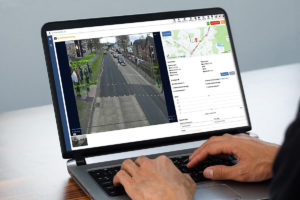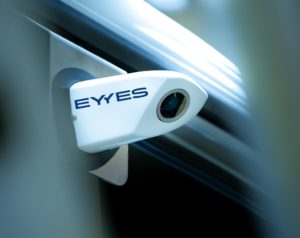
The manufacturers of AI dashcams and outside cameras say the big advantage over older camera systems is their ability to detect movement of pedestrians and drivers and capture high-quality images while avoiding irrelevant information.
For example, VisionTrack recently launched its Notification, Analysis and Risk Assessment (Nara) system, which can be integrated with existing connected camera technology including third-party hardware.
It uses computer vision models with sensor fusion to assess footage of driving events including accidents, enabling the review process to be more manageable and timely.
Advanced object recognition uses deep learning algorithms to automatically identify different types of vehicles, cyclists and pedestrians.
With high accuracy levels, it can distinguish between collisions, near misses and false positives that can be generated by factors such as potholes or speed humps.
The software also includes an occupant safety rating that uses a range of parameters to calculate the percentage probability of injury and immediately identify if a driver needs assistance.
During testing of the system, a 1,100-strong logistics fleet was typically found to be generating on average 2,000 priority videos a week, which would typically take someone more than eight hours to review.
However, according to VisionTrack, Nara reduced the time needed to review events that require human validation to minutes per day.
Richard Kent, President of Global Sales at VisionTrack, said: “Nara proactively removes false positives and monitors driver behaviour without the need for human involvement.
“With traditional video telematics solutions, commercial fleets can be experiencing hundreds of triggered daily events, so this will enable them to deliver more efficient working whilst not compromising on road safety.”
Meanwhile, the latest cameras from Brigade Electronics use Artificial Intelligence and machine learning, and image processing is built in to the camera, meaning that no other hardware is required.
The Careye AI camera is also predictive, meaning it will accurately evaluate images from cameras fitted to the vehicle and is able to calculate the future course of motion of nearby people or objects on the nearside of a vehicle within the pre-defined detection zone.
Based on this data, the system reliably and accurately warns the driver in real time of a possible collision before it occurs.
Warnings are issued either actively with an audible and visual red alert if an object is at risk of being hit, or passively with a visual yellow alert if, for example, a person is moving away from the danger zone, drastically reducing false alerts.
The company offers three types of cameras: one for the front, one for the rear and a premium range camera.
Emily Hardy, Marketing Manager of Brigade Electronics UK, said: “The accuracy of Careye’s AI makes false alerts extremely rare and provides the driver with absolute peace of mind that they can manoeuvre their vehicle with the utmost safety.
“The system is able to differentiate between cars, trucks, people, bicycles and static objects, such as trees or bollards. Movement and the expected direction is then calculated, making the system extremely reliable.”

The forward-facing camera captures high quality footage of the road ahead, while the driver-facing lens provides a greater understanding of the risks of driver distraction within the vehicle.
The MV-and AI-capabilities work together to identify and assess risk inside and outside the vehicle, so the driver can be notified of any issues and footage uploaded to the cloud for review.
Accora, the medical seating and bed manufacturer, is using the technology across its fleet of vans.
Initial results have already demonstrated a 20% reduction in harsh driving events and an associated 15% improvement in fuel efficiency. The driver can be notified of issues in real time and footage uploaded to the cloud.
According to Accora, there was some initial reluctance amongst its drivers, but those that have tested the system now recognise it has encouraged improved driving habits.
Steve Thomas, Managing Director of Inseego UK, said: “Accora’s primary focus was very much around road safety, so we have been able to use the technology most suited to monitoring performance and empowering their drivers.
“The new AI dashcam is a hugely positive addition to our telematics offering, which is helping to recognise and prevent collisions happening in the first place.”
Teletrac Navman’s AI smart dashcams review every minute of drive time through forward and driver-facing cameras that capture driving behaviour together with incidents which can be reviewed retrospectively by the transport manager.
The system also learns on the job, allowing training to be continually fine-tuned as driver skill increases.
In addition, the driver can access the smart dashcams via a mobile app where actions and coaching events can be viewed, creating a positive culture around driver safety.
This application integrates with Teletrac Navman’s TN360 platform, and can notify drivers of potentially dangerous situations allowing them to take avoiding action, for example, it will alert a driver that might appear to be at risk of distraction behind the wheel.

“From a driver’s perspective, the AI engine is continually recording and learning, which means monitoring behaviour is tailored to each individual to make training more valuable and meaningful.”
More than 90% of crashes are a result of human error, with all motorists, cyclists and pedestrians required to take responsibility for their actions. Any technology that empowers operators and drivers to minimise fleet risk should be seen as a welcome development.








